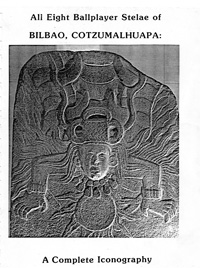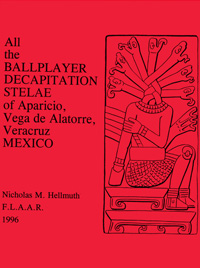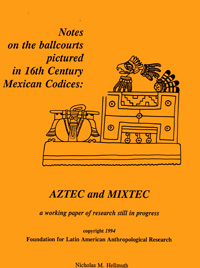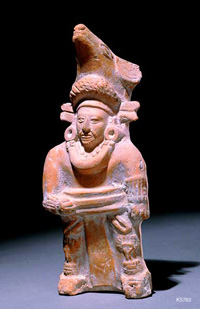SACRED SPORTS in 8th century pre-Hispanic Mexico
The Ancient Mesoamerican Ballgames of the Maya and Aztec
Virtually all descriptions of the native Mexican, Guatemalan and Honduras ballgames stress that hands were not allowed to touch the ball. Yet two 8th century Maya sculptures and several Peten Maya vases show players with their hands directly on the ball. How can we distinguish academic fact from romanticized fiction?
Considering how many books and articles have been written on the ancient ballgames of Mesoamerica, it is noteworthy how much additional information is now available that alters, indeed changes, many traditional academic beliefs.
| These reports are being scanned and as soon as we have funds available we will issue them as PDFs in electronic format. If you would like to donate to help this publication program, please contact us at [email protected]. Donations are tax-deductible. | |
 |
 |
 |
 |
 |
|
 |
| Ballgame player |
What is the source of this new information that allows Dr. Hellmuth to itemize the many ways in which the Classic Maya sports differ from games of the Aztecs?
Many 8th century Maya vases show entire teams at play: five carved vases are now known for the Yucatan area, several polychrome vases for southern Campeche, and at least ten polychrome vases for the Peten area of Guatemala. Also, the 7th century stucco roof comb statues of Labna once displayed a complete game. This fantastic scene on the Labna flying facade even reveals how the stairways of the ballcourts were used. Several vases also show the role of the stairways for the ceremonies associated with this ritualized sport.
More than fifty 8th century stone sculptures are available which picture the game as it was really played by the Maya of Mexico, Guatemala, and Honduras. The most recent discovery in ballgame iconography was by Vincent Phillips, who recognized that Stela 66 at Calakmul pictured the dynastic ruler dressed as a ballplayer. This fact had not previously been listed in any publication on Maya stelae
Stone yokes vs wooden ball deflectors
Most scholars state that stone yokes are too heavy to have actually been worn by athletes (these writers claim that stone yokes were worn only in parades). Yet Hellmuth has himself worn a yoke while running around the ballcourt of Copan. This was filmed for a documentary program by WBCC-TV Channel 68, Cocoa, FL. This breakthrough, that the extra weight of a stone yoke could actually help in the active play, gained so much international publicity that Dr. Hellmuth was interviewed by a British film crew for the DISCOVERY Channel (Arthur C. Clarke's Mysterious Universe series). So at last you can get your answer to the question, is a stone yoke really too heavy to wear while playing the game?
At his recent lecture in a major museum he borrowed a yoke from the exhibit, put it on, and ran up and down the aisle, demonstrating rather conclusively that stone yokes could easily be worn in active movement. If you wish, Hellmuth can bring the video to you of him wearing the yoke in the Copan ballcourt.
But in reality, most Classic Maya ballplayers did not wear yokes at all (neither of wood nor stone). Most Lowland Maya ballplayers wore wooden and/or leather outfits WHICH ARE NOT YOKES, these are ball deflectors. A yoke is worn around the waste in most cases; a ball deflector is worn about the chest in most cases.
Dr. Nicholas Hellmuth has taught university courses on the native American ballgames and is the author of three volumes already in print (1975 and 1987) and seven more volumes in press on various aspects of the Maya, Aztec, Teotihuacan, and El Tajin games.
The Maya ballgame as reenactment of deer hunting
All the popular nonsense on the pre-columbian ballgames is so focused on human sacrifice and other aspects that they lose track of the actual real 8th century games. Many games of the Maya were to reenact a hunt. Yes, admittedly the hunt could be a metaphore for warfare (hunting your enemy), but the outfits are comparable to those worn by deer hunters.
An unexpected discovery from most vases and some sculptures was that many Maya athletes wore the same headdresses as did deer hunters. Several athletes even wear the same rare type of pants that Maya hunters wear. In other cases, ballplayers wear headdresses of warriors. It seems that hunting (whether hunting deer or hunting other men) was one ritual association for ancient ball sports in Mexico. This discovery is recent and is thus not yet widely known.
But yes, there was human sacrifice associated with Mayan ball games
Even more fascinating (and unexpected) is that several vases picture captives playing the game. These vanquished warriors were most likely captured in battle with neighboring Maya cities. These doomed individuals were then sent into the ballcourts for their final combat, as gladiators. This martial aspect of the game has raised considerable curiosity and thus prompted frequent requests for this lecture topic, since people want to learn about all these new discoveries in the Maya world.
The crucial thing when working with the Maya ballgame is to remember that the Maya played two main kinds of game: handball and "big ball". Their "big ball" game had two main variations, that played by dynastic rulers and that played by other members of the elite. Each variant could be played using either stone yugos low around their waist or wooden ball deflectors high on their chest. There seem to have been three classes of "goals". These will be described and illustrated in the lecture.
This slide show is also accompanied with illustrations of all the major ballcourts (Yaxchilan, Palenque, Tikal, Seibal, Tonina, Chinkultic, Chichen Itza, Tula and other key sites). These illustrations are by architect David Morgan, to be used for an upcoming book by Hellmuth on ballcourt architecture. T. W. Rutledge has prepared other drawings to recreate how the game was actually played.
The speaker's photographs of ballgame vases have been widely published. Overall, his archive of 35mm color slides of pre-Columbian Mesoamerican ballgame art is the largest in the world. Thus you can count on a slide show that will be well documented with slides of professional quality.
Where else can you find an archaeologist who has played the game himself and even brings the game into the auditorium along with colorful slides (some of which have been published by National Geographic)?
To help provide factual information on actual prehispanic games
FLAAR has dedicated several years to researching all aspects of the Maya, Aztec, Mixtec and other precolumbian ballgames. These dozen reports were issued in limited edition in the last 1990s as part of the Mayan conferences at Brevard Community College, during the years that FLAAR was on the campus of that college. Now, in 2010, we are digitizing all these publications and will issue them in electronic format.
Would you like to learn how to do rollout photographs of Maya vases?
Most recently updated May 25, 2010.
New page format posted November 16, 2009
Updated June 15, 1998, revised March 3, 1999; links added March 5, 2000